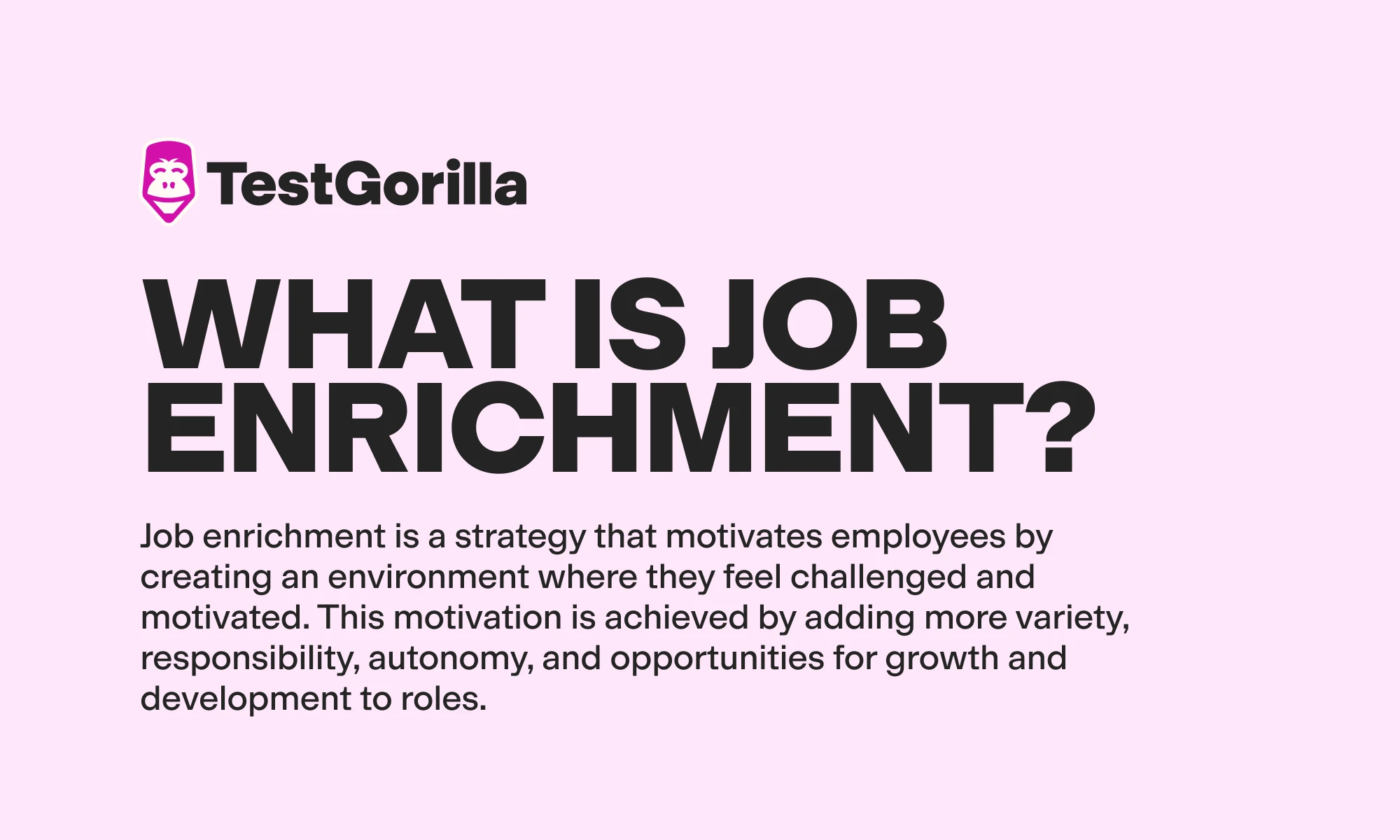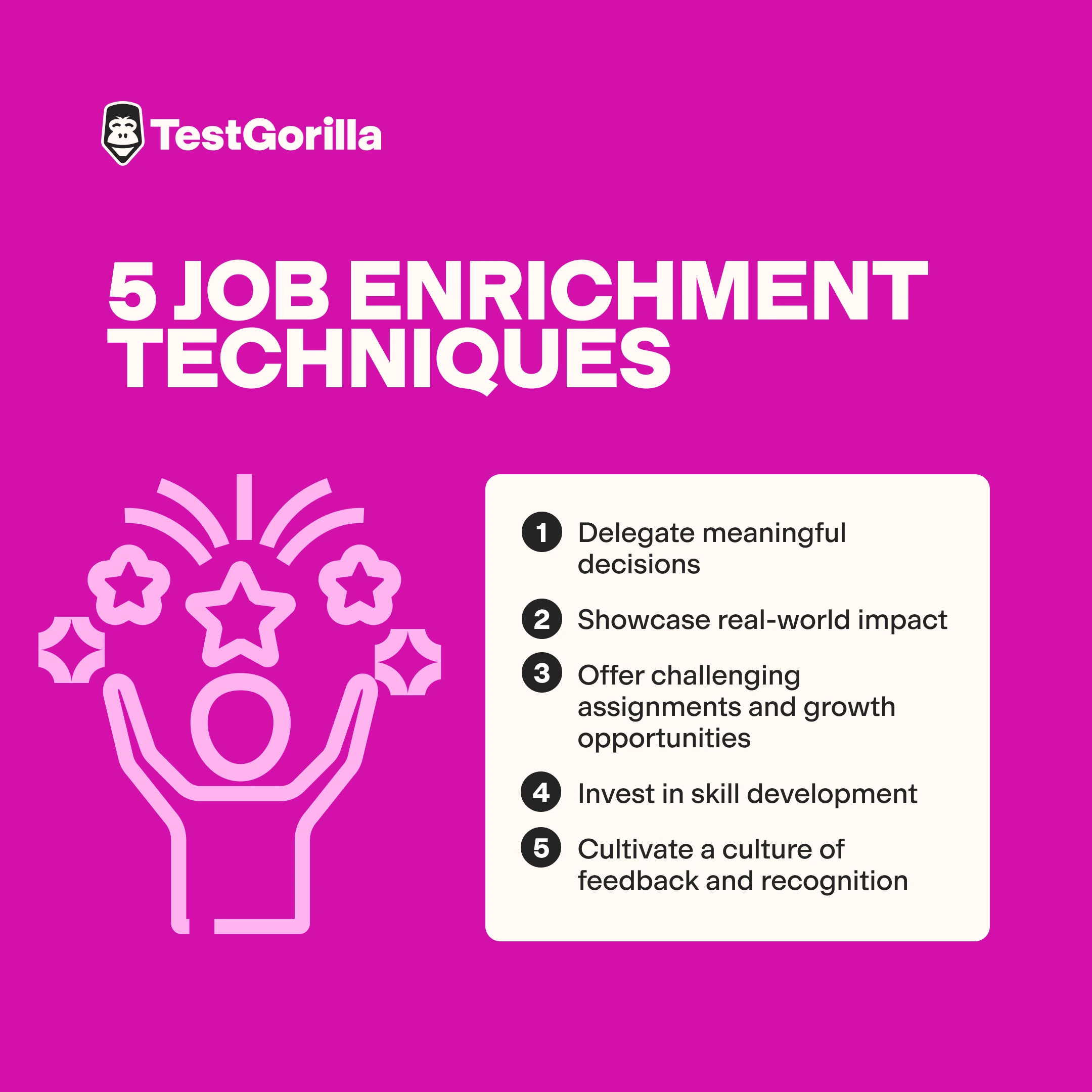As a recruitment professional, you know how much work goes into finding the perfect candidate for a role. You then need to make sure you successfully onboard them to set them up for success in their new job.
After all this effort, the last thing you want to do is lose a talented team member because they become demotivated and disengaged. To guarantee you retain the best talent and keep them performing at their best, you need a toolbox full of strategies that motivate, engage, and empower your team.
Today, you’ll learn about job enrichment as one such strategy – what it is, why it works so well, and how you can successfully implement it to get the most out of your employees.
Key takeaways
Job enrichment motivates employees by increasing their responsibility, autonomy, and opportunities for growth, leading to higher job satisfaction and productivity.
It differs from upskilling (deepening skills within a role), cross-skilling (acquiring skills from other departments), and job enlargement (adding more tasks at the same level).
Job enrichment is good for businesses because employees are more likely to be satisfied with their jobs when they feel more valued. This boost in satisfaction helps improve productivity and reduce staff turnover.
Potential risks of job enrichment include increased workload and stress, skill gaps, resistance to change, and misalignment with individual preferences.
What is job enrichment?
Job enrichment is a strategy that motivates employees by creating an environment where they feel challenged and motivated. This motivation is achieved by adding more variety, responsibility, autonomy, and opportunities for growth and development to roles.
The concept was developed in the 1960s by Frederick Herzberg, an American psychologist and one of the most influential names in business management. He believed empowering employees with more control and the ability to make decisions over their tasks – rather than just giving them more tasks – increases their motivation.
Job enrichment can seem similar to other motivational strategies you may already know. So, let’s take a closer look at some of those and see how they differ from job enrichment.
Upskilling
Upskilling is the process of teaching new skills to advance someone’s knowledge within their current field. This allows them to perform at a higher level and adds depth to their role. Adding depth happens in job enrichment, but upskilling achieves it in a different way.
Job enrichment changes the role itself by adding new responsibilities and decision-making, while upskilling helps staff become more proficient at what they’re already doing. Upskilling can be a part of achieving job enrichment, but it isn’t the focus.
Cross-skilling
Cross-skilling is similar to upskilling because it involves adding more knowledge and proficiency. However, it differs from upskilling and job enrichment because rather than adding depth within the current area of expertise, it adds a broader range of skills from other functional departments, improving versatility across a departmentalized organization.
For example, someone in the marketing department might learn new skills from the accounting team. This type of motivational strategy helps keep things fresh for staff, like job enrichment, but it approaches it very differently.
Job enlargement
Job enlargement is about adding more tasks to an employee’s workflow at the same level of complexity they’re used to. This added workload can help reduce boredom by increasing variation and reducing monotony.
While job enlargement focuses on adding breadth to a role, job enrichment adds depth. Job enlargement is also seen as a more temporary fix. It doesn’t add the same level of empowerment as job enrichment, which is needed for sustained motivation.
The best insights on HR and recruitment, delivered to your inbox.
Biweekly updates. No spam. Unsubscribe any time.
Benefits of job enrichment
Job enrichment is a strategy that really gets to the heart of what drives people to thrive in their roles. Because of this, there are several benefits for employees and businesses alike.
1. Benefits of job enrichment for employees
More autonomy in their roles provides employees with opportunities for skill development and personal growth. They can develop and strengthen soft skills like leadership, communication, and time management.
Likewise, more control over their work and schedule means employees can experience reduced boredom and improved productivity. As they structure their own time more, they no longer wait to be told what to do, which leads to less downtime and more proactive task handling.
The ultimate result for employees is increased job satisfaction and motivation. When empowered and trusted to handle more responsibility, employees embrace this and feel a greater sense of pride in their work. This increased feeling of achievement leads to happier employees who are driven to work hard.
2. Benefits of job enrichment for businesses
Implementing job enrichment strategies within your team also benefits your business. Some of these benefits are shared between businesses and employees. For example, improved productivity helps employees finish their work faster and saves money for your business.
When staff can make decisions for themselves, they can contribute their ideas more freely. This independence of thought encourages creativity and innovations that can benefit your company by improving processes and products.
Additionally, when staff feel more valued and trusted through job enrichment programs, they’re less likely to seek work elsewhere. This reduces staff turnover, helping keep hiring costs low.
Finally, by consistently using job enrichment strategies, your company can develop a reputation as a great workplace where employees can thrive under a culture of autonomy and trust. This will help you attract top talent in a competitive hiring environment.
3. Potential drawbacks of job enrichment
While job enrichment offers many benefits, there are some potential drawbacks.
As employees take on more responsibility and a diverse range of tasks, there’s a risk of role confusion. More freedom can cloud boundaries between different people’s responsibilities, and if this isn’t carefully handled through open and regular communication, it can negatively affect team cohesion.
Job enrichment programs may also come with training and development costs. If your budget is tight, you may not be able to afford this investment.
Lastly, job enrichment might not work for everyone. You must choose the right people to handle the additional workload and stress. If you give people additional autonomy before they’re ready, you may actually discourage them from taking on extra responsibility later in their careers.
5 job enrichment techniques
Here are five ways you can implement job enrichment with your employees:
1. Delegate meaningful decisions
Empower your employees by giving them decision-making responsibilities over things that actually matter in their work. Find areas for them to take ownership of things that best match their skills. These could include project planning, resource allocation, or task prioritization. Clearly communicate what’s necessary, provide training when needed, and scale the size of responsibility as they show competence.
For example, instead of micromanaging a marketing coordinator, give them the freedom to select which social media platforms the business uses for the next campaign.
2. Showcase real-world impact
Connect employees' daily tasks to the bigger picture of company success.
An easy way to do this is by sharing positive customer testimonials and directly linking them to your team’s work.
For example, you might highlight a recent positive customer review of a customer service team member. Showing that routine tasks impact the customer experience and, therefore, the business's reputation can increase employee engagement and instill a sense of purpose.
3. Offer challenging assignments and growth opportunities
Providing employees with assignments that take them out of their comfort zone offers them the chance to learn and grow. It also helps prevent stagnation and boredom within a job, which can lead to a talented employee looking elsewhere for a more interesting opportunity.
For example, you might allow a sales associate to present a pitch to a prospective client. This would enable them to develop not only their presentation skills but also their negotiation and leadership skills.
Remember to support your chosen employees through training or mentorship to set them up for success!
4. Invest in skill development
Offer employees the chance to develop skills within their current role. By itself, this is called upskilling, but when combined with additional responsibility, adding new skills plays an important role in motivating staff in job enrichment.
New skills can then be used on projects the employee wouldn’t normally work on. For example, a graphic designer may be encouraged to take a course in UX design and then apply what they’ve learned to redesign user flows on the company website.
5. Cultivate a culture of feedback and recognition
By setting up regular and meaningful feedback sessions, you create a system for celebrating successes and offering constructive criticism. This support network is a crucial part of job enrichment, lessening employees’ pressure when handling new professional responsibilities.
This feedback could be one-on-one weekly team meetings, a monthly employee spotlight where achievements are nominated, or an online peer-to-peer recognition system that can be used anytime.
How TestGorilla can help you drive job enrichment at your company
Job enrichment helps motivate employees by expanding their responsibilities and task variety within their roles. This has several benefits for your team and your business, from increased productivity to higher staff retention.
Of course, job enrichment also comes with some risks. If you don’t choose the right people to undergo job enrichment, they may be unable to handle the added responsibility and can quickly experience burnout.
So, how do you reliably identify employees with the right skills and potential for job enrichment?
A great place to start is with skills assessments from TestGorilla.
For example, if you’re considering job enrichment for a customer service rep to give them more autonomy over how they deal with complaints, you may give them the following three tests to see if they’re ready:
Problem-Solving test to identify if they can make effective decisions.
Communication Skills test to determine if they can express themselves clearly in a professional setting.
Customer Service test to understand how knowledgeable they are within their specific field.
TestGorilla has 350+ online tests that evaluate soft skills, job-specific skills, personality traits, and more. So whatever type of role you plan to add job enrichment to, you can assess the skills needed for success.
Get started with TestGorilla today by signing up for a free account or booking a live demo.
FAQs
What’s the difference between job enlargement and job enrichment?
Job enlargement adds more tasks at a similar complexity level to reduce monotony and boredom. Job enrichment adds depth and meaning to a job by increasing the employees' responsibilities, autonomy, and opportunities for growth and development.
What are the advantages and disadvantages of job enrichment?
The advantages of job enrichment are that it empowers employees to take on more responsibility within their current role. It challenges them to perform at their best, which increases productivity and reduces staff turnover as employees are more highly motivated.
Disadvantages of job enrichment include an increased workload and stress, which some people may not be able to handle. As a business, you may also need to pay for additional training and development, and you may face some resistance from employees who don’t like change.
What’s an example of job enlargement?
An example of job enlargement is a receptionist being assigned additional tasks, like data entry or filing, in addition to their existing duties of dealing with customers and making appointments.
You've scrolled this far
Why not try TestGorilla for free, and see what happens when you put skills first.




















